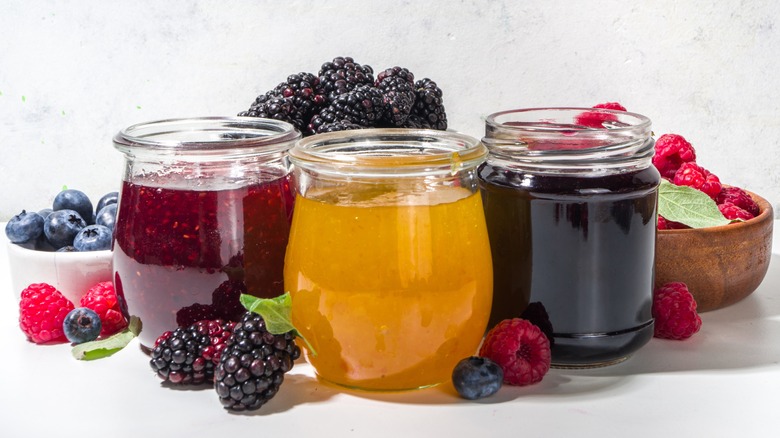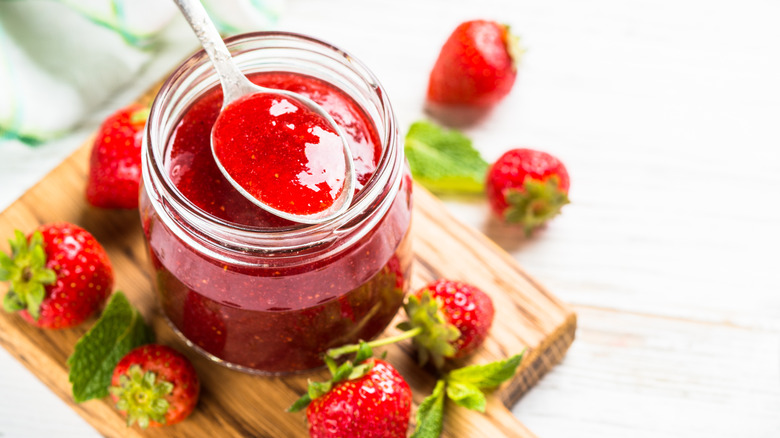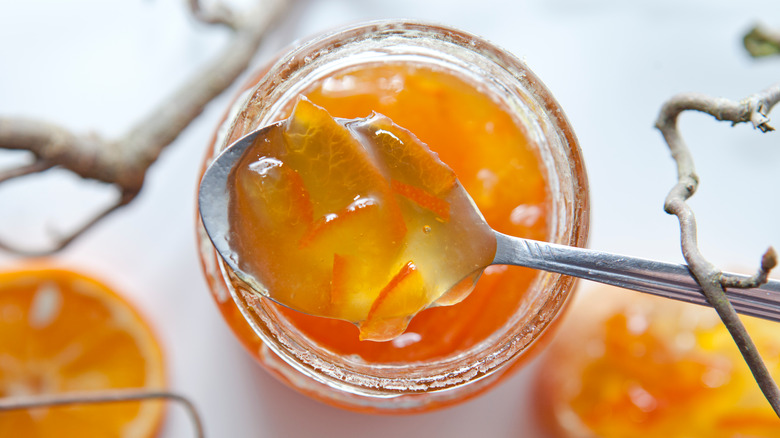The Key Difference Between A Jam And A Marmalade
Jams and marmalades have much in common, which is perhaps why they often wrongly pass off as the other. They're both made from some sort of fruit and sugar, stirred together until a thick, jiggly glob forms, thanks to pectin. Both tend to have a sweet taste and a spreadable consistency, which is why toasted bread and afternoon teas wouldn't quite be the same without either of them. Jam and marmalade often seem like two names for the same fruit spread.
As it turns out, however, there's a difference between jam and marmalade. While jams and marmalades are both made from fruit and sugar, the key difference lies in the kind of fruit and how much of it is actually used. Where jams are usually made from berries, apples, tomatoes, plums, peaches, and the like, marmalades are made using citrus fruits, such as oranges and lemons.
Jam and marmalade also differ in the parts of the fruit that are used to make them. Jams are made by simmering chopped fruit or fruit purées in sugar. But marmalades use pretty much the entire citrus fruit, including its rind and inner membranes. If you look closely, you'll find that this affects marmalade's texture, too, making it firmer and chunkier than the buttery consistency that's synonymous with jam.
Jams have a smoother texture
Jam can be made using any chopped, puréed, or whole fruit so as long as it's not citrus (in which case it would be marmalade) and the fruit isn't juiced (in which case the mixture would turn into a jelly). These fruits are then tossed in sugar and simmered in water.
As the heat breaks the fruit down and activates its pectin, the liquid mixture will thicken into a jammy consistency. Some fruits naturally have enough pectin to turn them into thick jams but when working with low-pectin fruits, such as apricots and peaches, it may be necessary to add pectin powders or other high-pectin ingredients, such as lemon juice, on top.
While some jams may contain the seeds or skin of the fruit along with its pulp, it's not always necessary. Barring a few exceptions, the FDA says that 45% of a jam should be its fruit, and the other 55% can be the sweetener — that is, sugar. It doesn't matter so much which part of the fruit is used. This affects jam's flavor and texture, which tends to be sweeter and smoother than marmalade's, making it easier to smear jam on toast or a scone. Jam's texture also helps it withstand the heat of an oven, which is why it's a popular filling in pies and tarts.
Marmalades are made using whole citrus fruits
Believed to be the product of centuries' worth of British reinvention on a Portuguese classic, marmalade's origin can be traced back to marmelada: a thick, jelly-like slab of quince paste eaten with bread, butter, and cheese in Portugal. Today, marmalades are more fruit preserves than jams or jellies and are made from citrus fruits including grapefruit, lemon, kumquat, lime, and, most popularly, bitter Seville orange.
Unlike jams, where anything other than the pulp of a fruit is optional, marmalades tend to use citrus rind, too — this is where a lot of the fruit's pectin resides. While marmalades are made pretty much the same way as jam, an additional step when making marmalade is to boil whole citrus fruits in plain water first, as this rids the rinds of their sharp bitterness. Boiled citrus fruits are then chopped into smaller pieces, along with their skin, before being left to cook and soften. Even the fruit's pectin-rich membranes and seeds are used during cooking to set the marmalade (they're scooped out later).
Due to the use of the citrus fruit's peel, marmalades tend to have a more firm, gelatinous, and chunky texture than jams. Their flavor is more complex, with a hint of bitterness to it. This makes marmalade an excellent fruit spread to use beyond toast. Pair its bitterness with a rich cheese, such as brie; add a chunky glob to an icy cocktail; or consider savory recipes, such as sauces and meat glazes.



